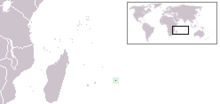Rodrigues night heron
| Rodrigues night heron | |
|---|---|

| |
| Skull and other elements | |
| Scientific classification | |
| Domain: | Eukaryota |
| Kingdom: | Animalia |
| Phylum: | Chordata |
| Class: | Aves |
| Order: | Pelecaniformes |
| Family: | Ardeidae |
| Genus: | Nycticorax |
| Species: | †N. megacephalus
|
| Binomial name | |
| †Nycticorax megacephalus (Milne-Edwards, 1874)
| |

| |
| Location of Rodrigues | |
| Synonyms | |
|
Ardea megacephala Milne-Edwards, 1874 | |
The Rodrigues night heron (Nycticorax megacephalus) is an extinct species of heron formerly occurring on the Mascarene island of Rodrigues.[1]
Taxonomy
It is known from subfossil bones[2] and the 1708 description of Leguat as well as the 1726 report of Julien Tafforet.
Description

The skull of the Rodrigues night heron was 154 long,the upper mandible was 94 mm and the lower was 147.[3]
Behaviour and ecology

Little is known about the behaviour of the Rodrigues night heron apart from the two contemporary descriptions.[4] Leguat's 1708 description, wherein he stated the bird fed on endemic Phelsuma geckos (likely the Rodrigues day gecko), reads as follows:
We had an abundance of Bitterns, as big and as good as capons; they are more familiar, and more easily to be caught than the Woodhens [Rodrigues Rail Erythromachus leguati ... They [Rodrigues Day-gecko Phelsuma edwardnewtoni] serve for Prey to some Birds, especially the Bitterns. When we beat ’em them down from the Trees with a pole, these Birds would come and devour them before us, tho’ we did our utmost to hinder them; and when we offer’d to oppose them, they came on still after their Prey, and still follow’d us when we endeavour’d to defend them.[4]
Milne-Edwards suggested in 1874 that the Rodrigues night heron had reduced power of flight, an opinion which Günther and Newton corroborated in 1879 by measuring the known wing-bones and founding all of them except the scapula to have been reduced in size and strength, while retaining the same shape as those of other herons.[5]
Tafforet's account reads as follows:
There are not a few Bitterns which are birds which only fly a very little, and run uncommonly well when they are chased. They are of the size of an egret and something like them.[4]
Both authors agree that this bittern-like bird, the size of a fat chicken[clarification needed] or small egret, was mainly terrestrial, unwary, and only flew when chased, although even in that case they initially tried to escape by running. They apparently laid greenish eggs; one of their favorite foods was geckos, probably the Rodrigues day gecko as the other local species, the Rodrigues giant day gecko was nearly as long as the bird itself (both gecko species are nowadays extinct too). Analysis of the fossil remains concluded that the bill of the species was very strong (hence the name megacephalus, i.e. "large-headed") and that it was evolving towards flightlessness.[6]
Many other species endemic to Rodrigues became extinct after humans arrived, and the island's ecosystem is heavily damaged. Before humans arrived, forests covered the island entirely, but very little remains today. The Rodrigues night heron lived alongside other recently extinct birds, such as the Rodrigues solitaire, Rodrigues parrot, Newton's parakeet, Rodrigues rail, Rodrigues scops owl, Rodrigues starling, and the Rodrigues pigeon. Extinct reptiles include the domed Rodrigues giant tortoise, the saddle-backed Rodrigues giant tortoise, and the Rodrigues day gecko.[7]
Extinction
The bird appears to have been hunted to extinction in the mid-18th century. Pingré mentions in his report that no "bitterns" could be found on Rodrigues anymore in 1761.[citation needed]
References
- ^ a b BirdLife International (2016). "Nycticorax megacephalus". IUCN Red List of Threatened Species. 2016: e.T22728787A94996659. doi:10.2305/IUCN.UK.2016-3.RLTS.T22728787A94996659.en. Retrieved 12 November 2021.
- ^ "Rodrigues Night-heron (Nycticorax megacephalus)". www.hbw.com. Retrieved 2018-04-02.
- ^ Rothschild, W. (1907). Extinct Birds. London: Hutchinson & Co. p. 111–115. OCLC 191907718.
- ^ a b c Hume, J. P. (2017). Extinct Birds (2 ed.). Croydon: Bloomsbury Natural History. pp. 80–81. ISBN 978-1-4729-3744-5.
- ^ Günther, A.; Newton, E. (1879). "The extinct birds of Rodriguez". Philosophical Transactions of the Royal Society of London. 168: 423–437. Bibcode:1879RSPT..168..423G. doi:10.1098/rstl.1879.0043.
- ^ "Rodrigues Night Heron - Nycticorax mauritianus". www.mauritiusencyclopedia.com. Retrieved 2018-04-02.
- ^ Cheke, A. S.; Hume, J. P. (2008). Lost Land of the Dodo: an Ecological History of Mauritius, Réunion & Rodrigues. T. & A. D. Poyser. pp. 49–52. ISBN 978-0-7136-6544-4.
- Cheke, A.S. 1987. An ecological history of the Mascarene Islands, with particular reference to extinctions and introductions of land vertebrates. In: Diamond, A.W. (ed.), Studies of Mascarene island birds, pp. 5-89. Cambridge University Press, Cambridge, U.K.
- Cowles, G. S. 1987. The fossil record. In: Diamond, A.W. (ed.), Studies of Mascarene Island birds, pp. 90-100. Cambridge University Press, Cambridge, U.K.
- Hachisuka, M. 1953. The Dodo and kindred birds. Witherby, London.
- Milne-Edwards, Alphonse (1873): Recherches sur la faune ancienne des Îles Mascareignes. Ann. Sci. Nat. Zool. (Paris) 5(19), Article 3, plate 14. [Article in French] Note: Usually, the year of publication is given as 1874. However, although the volume was nominally of that year, it was already released in 1873.

